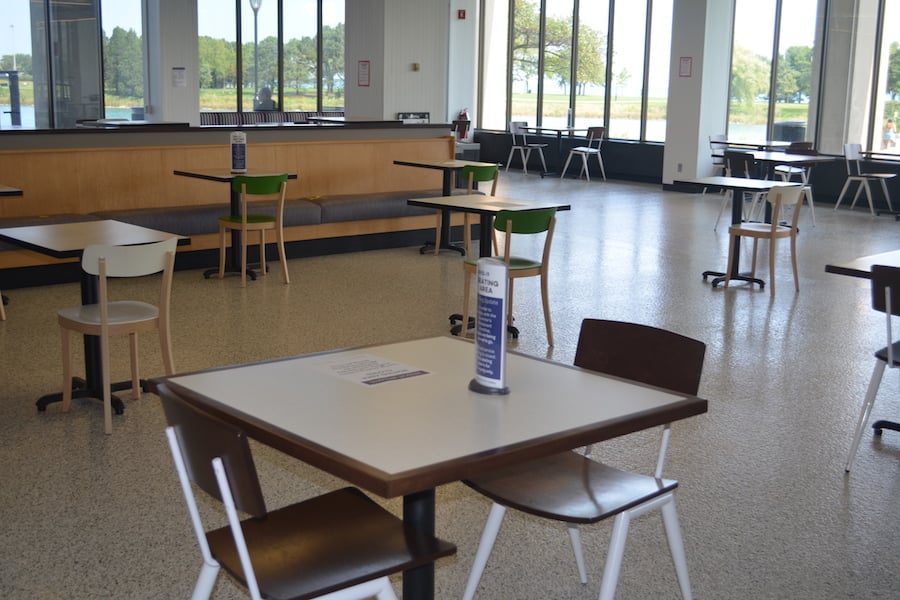Dining services adjust to Wildcat Wellness, COVID-19 restrictions
Binah Schatsky/The Daily Northwestern
Tables and chairs are spaced six feet apart in preparation for in-person dining at Northwestern.
September 18, 2020
Despite initial student speculation, Northwestern will not be going viral on TikTok for serving moldy food during Wildcat Wellness. However, dining during and after the first week of school will look very different from last year.
As part of Wildcat Wellness, students on campus order lunch and dinner for each day prior to their arrival, choosing from a menu with four options for each meal. The options are aligned with various stations of the dining halls, including Pure Eats, Rooted, Comfort and Kosher, and each contains a vegetable, side and main dish, according to the Northwestern Dining website.
Meal pick-up is between 12 to 2 p.m. and 5:30 to 7:30 p.m. in dorm lobbies. Students also receive breakfast bags, snacks and water with fruit, Nutri-Grain bars and Pop-Tarts, and they could grab new bags from their lobby when they need to replenish. Students in quarantine and isolation housing will receive both a hot and a cold meal midday and have access to microwaves and fridges to preserve and heat their food.
McCormick junior Zachary Vexler said the food quality is no different than the “typical fare” at the dining halls. His one complaint is the lack of flexibility, but he said he understands that making each meal completely customizable would make it too complicated.
“I would prefer to have a better choice of the options, because sometimes I prefer the entree for one but the vegetable side on the other would be better,” Vexler said. “There’s no mixing and matching, and I totally understand why they can’t do that just because it would be like a logistical nightmare.”
After videos of moldy and insufficient meals at New York University and other universities went viral on TikTok, students, including Communication sophomore transfer Aerin Gelblum, expressed concerns about what meals would be like when they came to NU.
“I was honestly a little nervous because I had seen how the food was being handled at NYU, and people were just getting like an apple and some chips,” Gelblum said. “But it’s much better than that. It’s warm, which is nice. And everyone I’ve interacted with who brought the food has been super friendly.”
Starting on Sept. 21, the Allison and Sargent dining halls, Lisa’s Cafe, Viet Nom Nom (formerly home to Asiana Foodville) and MOD Pizza will open for normal operating hours and indoor seating, in addition to The Market at Norris University Center and Starbucks, which opened on Monday. The open access meal plan has remained the same with the exception of three additional meal exchanges per week rather than two.
Students are asked to make reservations through the Dine on Campus app for Allison and Sargent during peak meal times, but seating is ultimately first-come, first-serve and reservations won’t guarantee seating.
The Boost mobile ordering app is also available and will allow students to order a meal for a specific time. People who feel uncomfortable entering the serving area will be able to avoid the lines. According to an email from Georgene Sardis, the director of marketing for Compass at Northwestern, Boost will be available at most dining halls and retail locations. Students can use meal swipes at the dining halls and meal exchanges or dining dollars at retail locations.
Everyone with a meal plan will be provided with a reusable OZZI container and can exchange it for a clean one for each meal, while other to-go packaging will be utilized for mobile orders and those without a reusable container. Depending on how the transition to in-person dining goes, there may be a transition from to-go containers to standard plates and silverware.
According to an email from Sardis, NU Dining “has instilled social distancing measures, including fewer guests per table, (and) ensuring six foot spacing signs in all food lines, limiting capacity in dining venues… students are expected to follow University guidelines as outlined on the University’s COVID-19 site.” Staff will be provided with personal protective equipment such as masks and gloves while “increased handwashing and enhanced sanitation practices” will be implemented and plexi-guards installed to protect cashiers.
Despite the precautions, however, eating inside at a dining hall during the pandemic still feels risky for some.
“I would absolutely not be comfortable eating there,” Vexler said. “I would not feel comfortable eating like in a room with hundreds of other people not wearing masks.”
Email: [email protected]
Twitter: @haley_fuller_
Related Stories:
— Northwestern to close some dining halls this fall, Compass Group to lay off about 100 staff members
— Northwestern dining workers denied extension on health insurance, COVID-19 safety protections amid mass layoffs
— Workers and student allies deliver petition to Northwestern administrators calling for commitment to dining worker health and safety precautions












